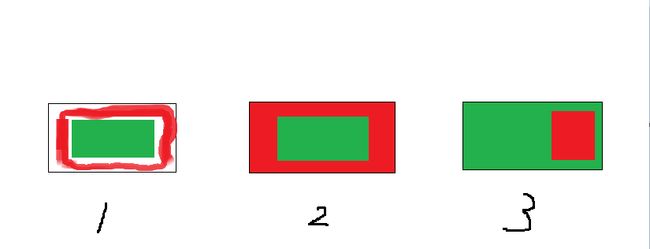译文的GitHub地址:RecyclerView之ItemDecoration由浅入深
译者注:RecyclerView第一篇,希望后面坚持下来
RecyclerView没有像之前ListView提供divider属性,而是提供了方法
recyclerView.addItemDecoration()
其中ItemDecoration需要我们自己去定制重写,一开始可能有人会觉得麻烦不好用,最后你会发现这种可插拔设计不仅好用,而且功能强大。
ItemDecoration类主要是三个方法:
public void onDraw(Canvas c, RecyclerView parent, State state)
public void onDrawOver(Canvas c, RecyclerView parent, State state)
public void getItemOffsets(Rect outRect, View view, RecyclerView parent, State state)
官方源码虽然都写的很清楚,但还不少小伙伴不知道怎么理解,怎么用或用哪个方法,下面我画个简单的图来帮你们理解一下。
图画的丑请见谅,首先我们假设绿色区域代表的是我们的内容,红色区域代表我们自己绘制的装饰,可以看到:
图1:代表了getItemOffsets(),可以实现类似padding的效果
图2:代表了onDraw(),可以实现类似绘制背景的效果,内容在上面
图3:代表了onDrawOver(),可以绘制在内容的上面,覆盖内容
注意上面是我个人从应用角度的看法,事实上实现上面的效果可能三个方法每个方法都可以实现。只不过这种方法更好理解。
下面是我们没有添加任何ItemDecoration的界面
主页布局界面很简单,背景设成灰色
//灰色背景
ok 接下来,让我们来实现实际开发中常遇到的场景。
padding
从前面的图可以看到实现这个效果,需要重写getItemOffsets方法。
public class SimplePaddingDecoration extends RecyclerView.ItemDecoration {
private int dividerHeight;
public SimplePaddingDecoration(Context context) {
dividerHeight = context.getResources().getDimensionPixelSize(R.dimen.divider_height);
}
@Override
public void getItemOffsets(Rect outRect, View view, RecyclerView parent, RecyclerView.State state) {
super.getItemOffsets(outRect, view, parent, state);
outRect.bottom = dividerHeight;//类似加了一个bottom padding
}
}
没错,就这么2行代码,然后添加到RecyclerView
recyclerView.addItemDecoration(new SimplePaddingDecoration(this));
实现效果:
分割线
分割线在app中是经常用到的,用ItemDecoration怎么实现呢,其实上面padding改成1dp就实现了分割线的效果,但是分割线的颜色只能是背景灰色,所以不能用这种方法。
要实现分割线效果需要 getItemOffsets()和 onDraw()2个方法,首先用 getItemOffsets给item下方空出一定高度的空间(例子中是1dp),然后用onDraw绘制这个空间
public class SimpleDividerDecoration extends RecyclerView.ItemDecoration {
private int dividerHeight;
private Paint dividerPaint;
public SimpleDividerDecoration(Context context) {
dividerPaint = new Paint();
dividerPaint.setColor(context.getResources().getColor(R.color.colorAccent));
dividerHeight = context.getResources().getDimensionPixelSize(R.dimen.divider_height);
}
@Override
public void getItemOffsets(Rect outRect, View view, RecyclerView parent, RecyclerView.State state) {
super.getItemOffsets(outRect, view, parent, state);
outRect.bottom = dividerHeight;
}
@Override
public void onDraw(Canvas c, RecyclerView parent, RecyclerView.State state) {
int childCount = parent.getChildCount();
int left = parent.getPaddingLeft();
int right = parent.getWidth() - parent.getPaddingRight();
for (int i = 0; i < childCount - 1; i++) {
View view = parent.getChildAt(i);
float top = view.getBottom();
float bottom = view.getBottom() + dividerHeight;
c.drawRect(left, top, right, bottom, dividerPaint);
}
}
}
实现效果:
标签
现在很多电商app会给商品加上一个标签,比如“推荐”,“热卖”,“秒杀”等等,可以看到这些标签都是覆盖在内容之上的,这就可以用onDrawOver()来实现,我们这里简单实现一个有趣的标签
public class LeftAndRightTagDecoration extends RecyclerView.ItemDecoration {
private int tagWidth;
private Paint leftPaint;
private Paint rightPaint;
public LeftAndRightTagDecoration(Context context) {
leftPaint = new Paint();
leftPaint.setColor(context.getResources().getColor(R.color.colorAccent));
rightPaint = new Paint();
rightPaint.setColor(context.getResources().getColor(R.color.colorPrimary));
tagWidth = context.getResources().getDimensionPixelSize(R.dimen.tag_width);
}
@Override
public void onDrawOver(Canvas c, RecyclerView parent, RecyclerView.State state) {
super.onDrawOver(c, parent, state);
int childCount = parent.getChildCount();
for (int i = 0; i < childCount; i++) {
View child = parent.getChildAt(i);
int pos = parent.getChildAdapterPosition(child);
boolean isLeft = pos % 2 == 0;
if (isLeft) {
float left = child.getLeft();
float right = left + tagWidth;
float top = child.getTop();
float bottom = child.getBottom();
c.drawRect(left, top, right, bottom, leftPaint);
} else {
float right = child.getRight();
float left = right - tagWidth;
float top = child.getTop();
float bottom = child.getBottom();
c.drawRect(left, top, right, bottom, rightPaint);
}
}
}
}
实现效果:
组合
不要忘记的是ItemDecoration是可以叠加的
recyclerView.addItemDecoration(new LeftAndRightTagDecoration(this));
recyclerView.addItemDecoration(new SimpleDividerDecoration(this));
我们把上面2个ItemDecoration同时添加到RecyclerView看下什么效果
是不是有种狂拽炫酷吊炸天的赶脚。。。
三个方法都用了一遍,你以为这就结束了?呵呵 并没有
section
这个是什么呢,先看下我们实现的效果
一看这个就很熟悉吧,手机上面的通讯录联系人,知乎日报都是这样效果,可以叫分组,也可以叫section分块 先不管它叫什么。
这个怎么实现呢? 其实和实现分割线是一样的道理 ,只是不是所有的item都需要分割线,只有同组的第一个需要。
我们首先定义一个接口给activity进行回调用来进行数据分组和获取首字母
public interface DecorationCallback {
long getGroupId(int position);
String getGroupFirstLine(int position);
}
然后再来看我们的ItemDecoration
public class SectionDecoration extends RecyclerView.ItemDecoration {
private static final String TAG = "SectionDecoration";
private DecorationCallback callback;
private TextPaint textPaint;
private Paint paint;
private int topGap;
private Paint.FontMetrics fontMetrics;
public SectionDecoration(Context context, DecorationCallback decorationCallback) {
Resources res = context.getResources();
this.callback = decorationCallback;
paint = new Paint();
paint.setColor(res.getColor(R.color.colorAccent));
textPaint = new TextPaint();
textPaint.setTypeface(Typeface.DEFAULT_BOLD);
textPaint.setAntiAlias(true);
textPaint.setTextSize(80);
textPaint.setColor(Color.BLACK);
textPaint.getFontMetrics(fontMetrics);
textPaint.setTextAlign(Paint.Align.LEFT);
fontMetrics = new Paint.FontMetrics();
topGap = res.getDimensionPixelSize(R.dimen.sectioned_top);//32dp
}
@Override
public void getItemOffsets(Rect outRect, View view, RecyclerView parent, RecyclerView.State state) {
super.getItemOffsets(outRect, view, parent, state);
int pos = parent.getChildAdapterPosition(view);
Log.i(TAG, "getItemOffsets:" + pos);
long groupId = callback.getGroupId(pos);
if (groupId < 0) return;
if (pos == 0 || isFirstInGroup(pos)) {//同组的第一个才添加padding
outRect.top = topGap;
} else {
outRect.top = 0;
}
}
@Override
public void onDraw(Canvas c, RecyclerView parent, RecyclerView.State state) {
super.onDraw(c, parent, state);
int left = parent.getPaddingLeft();
int right = parent.getWidth() - parent.getPaddingRight();
int childCount = parent.getChildCount();
for (int i = 0; i < childCount; i++) {
View view = parent.getChildAt(i);
int position = parent.getChildAdapterPosition(view);
long groupId = callback.getGroupId(position);
if (groupId < 0) return;
String textLine = callback.getGroupFirstLine(position).toUpperCase();
if (position == 0 || isFirstInGroup(position)) {
float top = view.getTop() - topGap;
float bottom = view.getTop();
c.drawRect(left, top, right, bottom, paint);//绘制红色矩形
c.drawText(textLine, left, bottom, textPaint);//绘制文本
}
}
}
private boolean isFirstInGroup(int pos) {
if (pos == 0) {
return true;
} else {
long prevGroupId = callback.getGroupId(pos - 1);
long groupId = callback.getGroupId(pos);
return prevGroupId != groupId;
}
}
public interface DecorationCallback {
long getGroupId(int position);
String getGroupFirstLine(int position);
}
}
可以看到和divider实现一样,都是重写getItemOffsets()和onDraw()2个方法,不同的是根据数据做了处理。
在Activity中使用
recyclerView.addItemDecoration(new SectionDecoration(this, new SectionDecoration.DecorationCallback() {
@Override
public long getGroupId(int position) {
return Character.toUpperCase(dataList.get(position).getName().charAt(0));
}
@Override
public String getGroupFirstLine(int position) {
return dataList.get(position).getName().substring(0, 1).toUpperCase();
}
}));
干净舒服,不少github类似的库都是去adapter进行处理 侵入性太强 或许ItemDecoration是个更好的选择,可插拔,可替换。
到这里细心的人就会发现了,header不会动啊,我手机上的通讯录可是会随的滑动而变动呢,这个可以实现么?
StickyHeader
这个东西怎么叫我也不知道啊 粘性头部?英文也有叫 pinned section 取名字真是个麻烦事。
先看下我们简单实现的效果
首先一看到图,我们就应该想到header不动肯定是要绘制item内容之上的,需要重写onDrawOver()方法,其他地方和section实现一样。
public class PinnedSectionDecoration extends RecyclerView.ItemDecoration {
private static final String TAG = "PinnedSectionDecoration";
private DecorationCallback callback;
private TextPaint textPaint;
private Paint paint;
private int topGap;
private Paint.FontMetrics fontMetrics;
public PinnedSectionDecoration(Context context, DecorationCallback decorationCallback) {
Resources res = context.getResources();
this.callback = decorationCallback;
paint = new Paint();
paint.setColor(res.getColor(R.color.colorAccent));
textPaint = new TextPaint();
textPaint.setTypeface(Typeface.DEFAULT_BOLD);
textPaint.setAntiAlias(true);
textPaint.setTextSize(80);
textPaint.setColor(Color.BLACK);
textPaint.getFontMetrics(fontMetrics);
textPaint.setTextAlign(Paint.Align.LEFT);
fontMetrics = new Paint.FontMetrics();
topGap = res.getDimensionPixelSize(R.dimen.sectioned_top);
}
@Override
public void getItemOffsets(Rect outRect, View view, RecyclerView parent, RecyclerView.State state) {
super.getItemOffsets(outRect, view, parent, state);
int pos = parent.getChildAdapterPosition(view);
long groupId = callback.getGroupId(pos);
if (groupId < 0) return;
if (pos == 0 || isFirstInGroup(pos)) {
outRect.top = topGap;
} else {
outRect.top = 0;
}
}
@Override
public void onDrawOver(Canvas c, RecyclerView parent, RecyclerView.State state) {
super.onDrawOver(c, parent, state);
int itemCount = state.getItemCount();
int childCount = parent.getChildCount();
int left = parent.getPaddingLeft();
int right = parent.getWidth() - parent.getPaddingRight();
float lineHeight = textPaint.getTextSize() + fontMetrics.descent;
long preGroupId, groupId = -1;
for (int i = 0; i < childCount; i++) {
View view = parent.getChildAt(i);
int position = parent.getChildAdapterPosition(view);
preGroupId = groupId;
groupId = callback.getGroupId(position);
if (groupId < 0 || groupId == preGroupId) continue;
String textLine = callback.getGroupFirstLine(position).toUpperCase();
if (TextUtils.isEmpty(textLine)) continue;
int viewBottom = view.getBottom();
float textY = Math.max(topGap, view.getTop());
if (position + 1 < itemCount) { //下一个和当前不一样移动当前
long nextGroupId = callback.getGroupId(position + 1);
if (nextGroupId != groupId && viewBottom < textY ) {//组内最后一个view进入了header
textY = viewBottom;
}
}
c.drawRect(left, textY - topGap, right, textY, paint);
c.drawText(textLine, left, textY, textPaint);
}
}
}
好了,现在发现ItemDecoration有多强大了吧! 当然还有更多就需要你自己去发现了。







